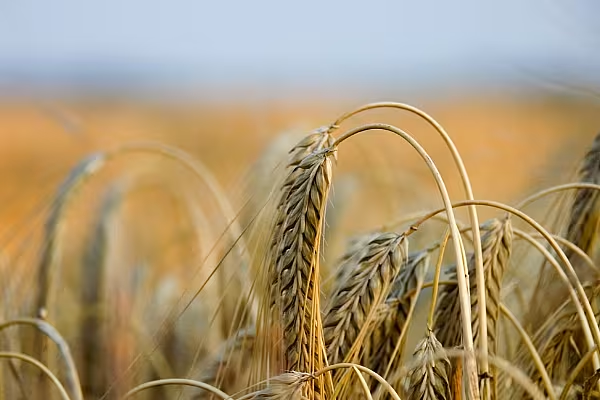Canada’s wheat farmers still have more than a month before they start the bulk of this season’s grain harvest, but they’re already worried about where to store a bumper crop.
Even though growers planted less after prices fell last year, beneficial weather boosted the outlook for yields across Canada’s Prairies. The potential for near-record output means farmers are stocking up on grain bags to store wheat on the ground amid expectations that bins and silos will be overflowing.
“There’s such a demand because the crop looks so big this year,” said Bruce Nordick, a sales manager at Grain Bags Canada. He estimates that sales volume is the biggest he’s ever seen for this time in the season in the 10 years that he’s been selling equipment. “We’re leaps and bounds ahead compared to last year and even 2013,” when farmers collected a record harvest, he said by telephone from Humboldt, Saskatchewan.
The big crop in Canada, one of the world’s top shippers, is adding to the outlook for a ballooning wheat glut. The U.S. Department of Agriculture already forecasts that global stockpiles will reach a record before North America’s 2017 harvest. Analysts surveyed by Bloomberg on average predict that supplies are so large that the agency will be forced to raise its inventory estimate. Benchmark prices in Chicago are down about 25 percent in the past 12 months, and hedge funds last week increased their wagers on further declines to the most since April.
‘Ideal Conditions’
Globally, “we had next to ideal conditions for wheat yields it seems, and we’ve been posting some very big numbers,” said Gillian Rutherford, who helps oversee about $12 billion as a commodities portfolio manager at Pacific Investment Management Co. in Newport Beach, California. “It’s difficult to imagine that prices are going to rally sharply.”
Hedge funds and other large speculators increased their net-short holdings in wheat to 102,244 U.S. futures and options in the week ended July 5, according to Commodity Futures Trading Commission data released three days later. Money managers have been betting on price declines for 11 straight months, the longest streak in the government data that starts in 2006.
Rolling most-active futures traded on the Chicago Board of Trade fell 7.1 percent this year. Prices touched $4.1575 on July 5, the lowest since 2007. Futures for spring wheat, the variety grown in Canada, have dropped about 17 percent over the past 12 months on the Minneapolis Grain Exchange.
In Canada, farmers may collect as much as 31 million metric tons of wheat this season, according to trader Gap SA Grains & Produits. That would be 12 percent higher than a year earlier and among the top five largest harvests on record. A crop of that size could strain the nation’s rail system and storage facilities, as it did in 2013 when C$20 billion ($15 billion) of grain was left stuck on farms as grain bins and elevators were full.
Summer Rain
Warm weather and summer rain have boosted plants. Growing conditions in Saskatchewan, Canada’s top grower, have been “optimal in most areas,” the province’s agriculture ministry said Friday. More than 80 percent of the crops in Alberta, the second-biggest producer, were in good-to-excellent condition as of July 5, the latest provincial data show.
“If things stay the way they are, I think we could probably have the best crop we’ve had,” Ian Boxall 40, said in a telephone interview from his 8,500 acre farm in Tisdale, Saskatchewan. He’s expecting to harvest at least 65 bushels of wheat per acre on the 1,600 acres he’s sown this year. That would be 23 percent higher than the 53 bushels per acre Canadian farmers collected on average in 2013.
It’s not just Canada where supplies are large. Farmers in the U.S. could collect 2.164 billion bushels, according to the average of 26 estimates in a Bloomberg survey. That would be the most in four years and top the USDA’s June estimate for 2.052 billion. The agency will update its outlook for global crops on Tuesday at noon in Washington.
Adverse weather in Europe could help to put a cap on the supply expansion. In France, the European Union’s biggest grower, excess rain has raised concerns about yields and protein-content in plants. Soggy fields mean that the the country’s crop conditions have been falling.
Crop losses and quality problems in France could be a boon to Canadian and northern U.S. farmers, who typically produce spring-wheat varieties with higher protein than their global counterparts. North American prices could rise as buyers bid higher for shipments of better quality, even amid the worldwide glut.
“There’s really only one region of the world that produces high-protein wheat, and that’s the spring-wheat area of the U.S. Northern Plains and the Canadian Prairies,” said Louise Gartner, the owner of Spectrum Commodities in New Richmond, Ohio, who has been analyzing the market since 1988. “Countries looking to buy high-quality wheat to blend would look to the U.S. and Canada in particular.”
News by Bloomberg, edited by ESM. To subscribe to ESM: The European Supermarket Magazine, click here.














